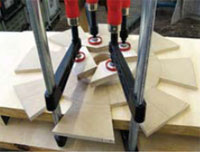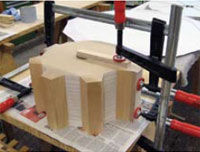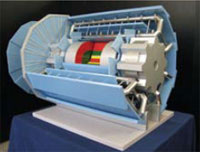ATLAS shrunk
Carpenters working at particle physics labs are used to jobs their colleagues in private industry wouldn't dream of tackling.
 |
 |
 |
| Photos courtesy of DESY carpenters |
But a request to build a wooden replica of the world's largest particle detector took even the carpenters at the German laboratory DESY by surprise.
Scientists asked them to build a model of the 7000-metricton ATLAS detector from CERN's Large Hadron Collider at 1/25th actual size—two meters wide and one meter in diameter.
The intricate work took seven months.
To fit tools, paint, and their hands into the model, the crew had to assemble the model from the innermost layer outward. “Sometimes we wished we could just weld things together as though it were the real thing,” says head carpenter Werner Biegger.
The team of five had to work out a complicated choreography of tasks to make sure everything could be reached and painted in just the right order. And that's not just one coat of paint: “Foundation, priming, more foundation, sanding down, first coat, sanding down, second coat, then finishing layer,” Biegger recites.
In the finished product, bright-blue muon chambers surround the ATLAS detector like the planks of a wine barrel. Six aluminum magnet coils curve around the inner subdetectors, and a plastic workman balances on the outer beam pipe. The coil and the toy are the only non-wooden parts.
“We wanted to make everything as realistic as possible,” Biegger says. “That's why we chose aluminum for the coils; no lacquer on wood could do that job.”
The model made its public debut in October and is now touring the country, showcasing the beauty of ATLAS and helping scientists explain how it works. Requests for other models are already trickling in.
Barbara Warmbein
Click here to download the pdf version of this article.






